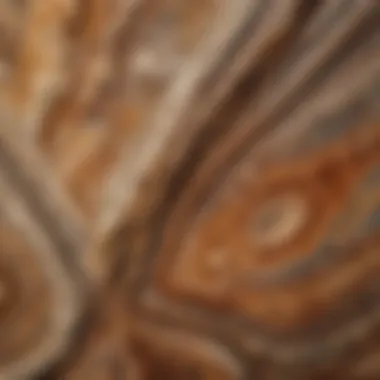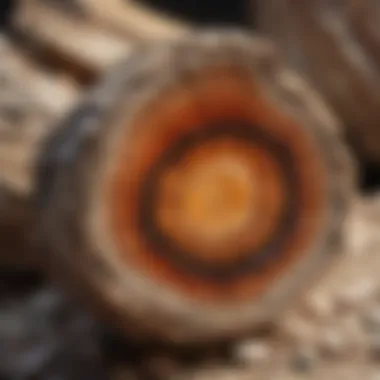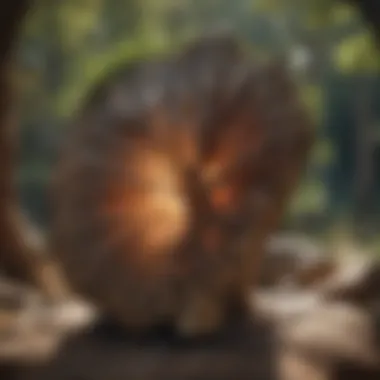Unveiling the Wonders of Petrified Wood Palm Stones


Intro
Petrified wood palm stones are more than just attractive natural artifacts. They embody a rich history, represent unique geological processes, and carry cultural significance. This article will guide you through their journey from ancient wood to fossilized beauty, exploring aspects of their formation, characteristics, and value to collectors.
History and Origins
Overview of Collectibles, Rocks, and Fossils
Petrified wood is a form of fossil that occurs when plant material, mainly trees, is buried under sediment and mineral-rich water. The organic material decomposes over time. Then, minerals like silica seep in and replace the wood's cellular structure. Gradually, the process transforms the wood into a hard stone-like material. Petrified wood comes in various forms, and palm stones are a popular choice among collectors for their polished surfaces and distinctive patterns.
Fossils serve as important historical markers. They tell stories of the earth’s past and reveal details about prehistoric life. Palm stones join the ranks of geological collectibles, providing both beauty and a connection to the past. Collectors value them for their aesthetics and the geological history they encompass.
Historical Significance and Cultural Impact
Historically, petrified wood has been revered in many cultures. Indigenous peoples often utilized it for tools and weapons. It symbolizes durability and longevity and compared favorably to other natural stones. Cultures around the world have associated it with spiritual and healing properties.
In the modern era, the rise of geology and paleontology has furthered interests in petrified wood palm stones. They are not just scientific specimens but also pieces of art crafted by nature. Their presence in museums, homes, and private collections reflects a deep appreciation for natural history.
"Petrified wood is a testimony to the passage of time, where nature's artistry meets human interest."
Identification and Classification
Guide to Identifying Rocks and Fossils
Identifying petrified wood palm stones involves examining various characteristics. Look for distinctive patterns, colors, and textures. The typical appearance of these stones showcases intricate designs resembling wood grain.
Common identification methods include:
- Visual Inspection: Check for specific patterns and colors.
- Hardness Test: Test with a scratch. On the Mohs scale, petrified wood is typically around 7.
- Weight and Density: Compare to similar stones to gauge authenticity.
Common Types and Variations
Petrified wood can be classified based on its mineral composition and the type of wood from which it originated. Here are notable variations:
- Agatized Wood: This form contains quartz in a highly crystalline state.
- Opalized Wood: Features opal, displaying vibrant colors and iridescence.
- Silicified Wood: Generally has a more subdued color palette with less luster.
Each type presents unique characteristics valuable for collectors and enthusiasts alike. Understanding these variations enhances appreciation and knowledge of petrified wood palm stones.
Foreword to Petrified Wood
Petrified wood stands as a captivating example of nature's ability to preserve and transform organic matter into fossilized form. In this section, we explore what defines petrified wood, its formation process, and its broader significance in geology and culture. Understanding this topic is vital for appreciating the multiple facets of petrified wood palm stones, which are sought after by collectors and enthusiasts alike. These palm stones offer not only aesthetic appeal but also a window into the Earth's history, showcasing the interplay between flora and geological processes over millions of years.
Definition and Formation
Petrified wood refers to a fossilized tree or tree-like plant that has undergone significant change through a process known as permineralization. This process occurs when the wood is buried under sediment and is infiltrated by mineral-rich water. Gradually, the organic material in the wood is replaced by minerals—most commonly silica, but also calcite, pyrite, and others.
The transformation from wood to stone occurs over long periods, sometimes millions of years. The cellular structure of the wood is preserved in remarkable detail, which can lead to impressive visual patterns resembling wood grain. This definition lays the groundwork for understanding how palm stones derive their unique aesthetics from this intricate process.
The Geological Process
The geological process that leads to the formation of petrified wood involves several stages. Initially, the wood must be buried quickly to prevent decay. This can occur from natural events like volcanic eruptions, sedimentation, or flood deposits. Once buried, the wood is protected from organisms that would otherwise degrade it.
As mineral-rich groundwater percolates through the sediments, minerals seep into the plant's tissues. Over time, the organic compounds break down, while the minerals crystallize. This dual process of preservation and replacement results in the conversion of the original cellulose structure into stone. The end product is a fossil that retains the original shape, texture, and sometimes even color variations of the wood.


This geological narrative is essential for collectors and scholars alike, as it highlights the diverse natural processes responsible for creating beautiful pieces of petrified wood palm stones. These stones are thus not just decorative items but also geological artifacts that encapsulate a unique story of transformation.
Understanding Palm Stones
Petrified wood palm stones are not merely geological curiosities; they serve as a tangible link to the past. Understanding what palm stones are and their unique characteristics is essential for collectors and enthusiasts alike. These stones represent a bridge between the natural world and human appreciation for beauty, history, and science. Knowing the specifics about palm stones helps in appreciating their aesthetic and intrinsic value.
What Are Palm Stones?
Palm stones can be defined as polished or tumbled pieces of petrified wood that typically fit comfortably in an adult's palm. They are smooth, rounded, and often thought to hold a special energy or quality. These stones are used in various contexts, from aesthetic displays in homes to tools for meditation and holistic healing.
The process of transforming a piece of wood into a palm stone involves several steps in lapidary work. First, the petrified wood must be selected for quality. The piece is then cut, shaped, and polished to enhance its visual appeal. This creates a tactile experience that fosters a deeper connection between the user and the natural artifact.
Characteristics of Petrified Palm Stones
Petrified palm stones possess several captivating characteristics:
- Color Variance: The colors of palm stones can range from deep browns and blacks to vibrant reds and greens. This variation often reflects the mineral content present during the fossilization process.
- Texture and Shine: Due to polishing, palm stones exhibit a smooth surface that can be glossy or matte. This texture makes them easy to handle and visually pleasing.
- Patterns and Inclusions: Each palm stone often contains unique patterns and inclusions, which provide insight into the environmental conditions during the wood's transformation. The presence of mineral traces adds to their collectibility.
- Weight Consideration: Although relatively lightweight, petrified wood palm stones can still carry substantial weight when compared to their size. This makes them feel solid in hand, adding to the tactile experience.
The characteristics of petrified palm stones enhance their appeal not just as decorative items but as objects of scientific interest and personal significance.
"Understanding the unique qualities of palm stones elevates the experience of collecting and interacting with these natural artifacts."
By appreciating the depth of features in palm stones, collectors can make informed choices about their acquisitions, whether for personal enjoyment, decor, or study. In the world of fossil collecting, recognizing these aspects can be vital for evaluating quality and authenticity.
Geological Significance of Petrified Wood
Petrified wood holds remarkable importance within geological studies, offering insights into ancient ecosystems and Earth’s climatic conditions over ages. Its existence represents a unique bridging of biological and geological processes, illustrating how life and environment intersect. By examining petrified wood, researchers can reconstruct not only the flora that once thrived but also infer broader environmental changes. This makes petrified wood a vital tool for understanding past climates and ecological transformations.
Petrified Wood in Earth's History
Petrified wood provides a vivid record of Earth’s geological time scale. The fossilization process, which involves the replacement of organic material with minerals, preserves the intricate details of the original wood structure. Each piece serves as a time capsule, locked within the sedimentary layers where it was formed.
- Age determination: The age of petrified wood can often be dated using radiometric methods. By confirming its age, scientists can place it within a specific period of Earth's history, contributing to our understanding of when certain plants flourished.
- Ecosystem reconstruction: Fossilized trees help reconstruct ancient ecosystems. For instance, finding petrified wood in a certain layer suggests the types of forests or woodlands present in that era. This data assists in piecing together the interplay of flora and fauna at that time.
Petrified wood is not just a fossil; it is an archive of the Earth's biological history, revealing the types of life that existed millions of years ago.
Petrified Wood and Paleontology
The study of petrified wood is intrinsically linked to paleontology. It acts as a key to unlocking many questions about prehistoric life. Understanding the context of these pieces can shed light on the evolutionary paths of different species, including how certain tree lineages adapted or became extinct.
- Link to climate change: Past climate events can be traced through the analysis of petrified wood. By studying the traits of the wood, such as growth rings or density, paleontologists can assess how ancient plants responded to changing climates, thus drawing parallels with present-day scenarios.
- Biodiversity development: The appearance of petrified wood in the fossil record indicates key moments in plant diversification. Analyzing different species reveals how plants adapted their structures, which in turn influenced the development of insect and animal populations.
The geological significance of petrified wood is multi-faceted. It serves as a critical resource in understanding how our planet has evolved, both biologically and environmentally. Collectors and researchers alike recognize the richness that these fossils provide. They are reminders of the dynamic history our planet has endured.
Uses of Petrified Wood Palm Stones
Petrified wood palm stones serve multiple purposes that extend beyond mere aesthetic appeal. They are valued by collectors and enthusiasts for their beauty and unique characteristics, but their importance also reaches into various cultural and spiritual realms. This section elaborates on both the collecting and decorative uses of palm stones, as well as their significance in healing and meditation practices.
In Collecting and Decor
For collectors, petrified wood palm stones represent unique fossilized specimens, appealing to both geological enthusiasts and casual collectors. These stones are often displayed as part of collections due to their intriguing textures and striking patterns. Collectors value the story behind each piece, making them more than just decorative objects.
- Aesthetic Appeal: The natural patterns and colors of petrified wood make these palm stones a beautiful addition to any collection. They blend well with various themes, from rustic to modern designs.
- Educational Value: These stones serve as educational tools, illustrating geological and paleontological processes. They can spark interest in geology in younger audiences or those unfamiliar with the subject.
- Investment Potential: The rarity of certain types of petrified wood can make these palm stones a lucrative investment in the long run. As collectors seek unique pieces, the value can increase.
"Each petrified wood palm stone is a window into the Earth's history, telling tales of ancient forests transformed by time."


For those interested in home decor, these stones can be used in various ways:
- Bookends or table centerpieces create focal points in a room.
- Natural art pieces can enhance your environment's ambiance.
- Gift items for nature lovers showcase thoughtfulness and appreciation for natural beauty.
In Healing and Meditation
Petrified wood palm stones are often associated with healing and meditation practices. Many believe these stones hold unique vibrations that can help in grounding and promoting emotional balance. Their smooth surfaces and comforting weights contribute to their beneficial properties during meditation.
- Grounding Energy: Users often report a feeling of stability when holding petrified wood palm stones. This grounding effect can help alleviate stress and encourage calmness.
- Enhanced Meditation Experience: Incorporating palm stones into meditation can enhance concentration. The tactile nature of the stones offers a point of focus, which can aid meditation practitioners in achieving deeper states of awareness.
- Support for Emotional Healing: Many proponents suggest that the energy from petrified wood can help in releasing negative patterns, fostering emotional healing, and promoting resilience.
In summary, petrified wood palm stones hold significant value in multiple dimensions—whether as collectibles, decorative items, or tools for healing and meditation. Their unique properties and historical relevance contribute to their allure, making them cherished items for individuals and collectors alike.
Cultural and Historical Perspectives
Exploring the cultural and historical significance of petrified wood palm stones helps illuminate their role beyond mere geological artifacts. Throughout history, these stones have been associated with various beliefs and practices. Their unique appearance and durability have drawn the attention of collectors and spiritual adherents alike. Understanding the ancient and modern uses of these stones provides insight into their enduring fascination.
Use in Ancient Civilizations
Ancient civilizations viewed petrified wood as a material imbued with both practical and mystical qualities. Archaeological findings suggest that communities as far back as the Egyptians utilized petrified wood for tools and ornamental items. This bears testament to the wood's resilience and unique aesthetic appeal. Notably, the Egyptians often associated wood with life and renewal, which made petrified pieces a symbol of continuity through time.
In Native American cultures, petrified wood held sacred significance. Tribes would often use it in rituals and as offerings. The notion of transformation—from living tree to stone—conveys profound spiritual meanings. The petrified remnants served as a reminder of the strength and permanence of nature, echoing the values these communities held dear.
The use of these stones reflects a blend of practicality and reverence. They were more than just objects; they were woven into the narratives and heritage of the people, serving as a link between the natural and the divine.
Symbolism in Modern Practices
In modern contexts, petrified wood palm stones continue to symbolize various ideals and practices. Many enthusiasts regard them as representations of stability and grounding. They are commonly used in meditation and wellness practices, believed to facilitate emotional balance and connection to the Earth.
Spiritual communities often attribute unique properties to these stones, viewing them as conduits for energy. Collectors appreciate the stones not only for their rarity but for their historical narratives—each piece telling a story of transformation and endurance.
Moreover, the aesthetic appeal of petrified palm stones in contemporary decor highlights their dual nature as both a collector’s item and a functional piece within home design. Their rich colors and patterns act as natural art, appealing to those who appreciate unique and authentic materials.
"Petrified wood palm stones are a bridge connecting the past to the present, serving as artifacts that resonate with human experience across ages."
The ongoing significance of petrified wood palm stones in both collecting and modern spirituality illustrates their lasting impact over time. As both a fossilized relic and a symbol of life, they offer a multi-faceted understanding of nature's power and the human inclination to find meaning in it.
Collecting Petrified Wood Palm Stones
Collecting petrified wood palm stones is an activity that blends natural history with personal interest. With their unique formation and geological characteristics, they appeal to both mineral enthusiasts and casual collectors alike. For many, engaging in this hobby can lead to a deeper appreciation of nature's processes and the historical context of fossilization. This section will explore how to identify authentic pieces and the various factors that may influence their value.
How to Identify Authentic Pieces
The first step in successfully collecting petrified wood palm stones is learning to recognize genuine specimens. Authentic petrified wood can be distinguished by several key characteristics:
- Coloration: Authentic pieces often display a rich array of colors, stemming from the mineral content absorbed during fossilization. Look for hues like brown, tan, and sometimes even deep blues or reds.
- Texture: True petrified wood maintains the texture of natural wood. It should feel smooth yet retain some of the original bark and grain patterns.
- Density: Compared to ordinary stones, petrified wood is usually heavier. This density arises from the replacement of organic materials with minerals. So, a significant weight difference can indicate its authenticity.
- Other Indicators: Look for cross-section cuts that reveal growth rings, a characteristic feature of trees. Authentic palm stones usually have recognizable grain patterns as well.
By examining these features closely, collectors can avoid forgeries that may not display these natural features adequately.
Factors Affecting Value
The value of petrified wood palm stones can fluctuate based on various elements. Here are some of the primary considerations:
- Rarity: Specimens that are rare or have unusual colors or patterns often carry higher value in the market. For example, specific types of petrified wood are found only in select geographic areas, increasing demand.
- Quality: The overall condition of the stone plays a significant role. Chips, cracks, or excessive wear can lower a specimen’s value. Well-preserved pieces are sought after by collectors.
- Size: Larger stones tend to be more valuable due to the increased material and visual impact they provide. However, size alone is not a determinant; quality still matters.
- Provenance: The origin of the stone can also affect its appeal. If a piece comes from a noted location renowned for fossilized wood, it can significantly increase its worth.
In summary, understanding the market and the characteristics of petrified wood palm stones can guide collectors in making informed decisions about their purchases. Being well-informed is crucial when adding to any collection.


Care and Maintenance of Petrified Wood
Caring for petrified wood palm stones is essential for preserving their beauty and integrity. These fossilized pieces are not only collectible items but also carry historical significance. Proper care ensures that these unique artifacts retain their charm and value over time. Collectors should be mindful of how they handle and maintain these stones to appreciate their natural elegance fully.
Cleaning Techniques
Cleaning petrified wood palm stones requires a gentle approach. Here are some recommended techniques:
- Use a Soft Cloth: A soft, dry cloth is usually sufficient for removing dust and smudges. This helps avoid scratches on the surface.
- Mild Soap Solution: For more stubborn dirt, mix a small amount of mild soap with water. Dampen a cloth with this solution and gently wipe the stone, rinsing with clean water afterward. Ensure the stone does not sit in water, as excess moisture can weaken it.
- Avoid Abrasives: Harsh chemicals or abrasive materials can damage the surface. Stay away from scrubbing pads or strong cleaners.
Maintaining cleanliness not only enhances the appearance of petrified wood but also shows respect for these natural artifacts.
Storage Recommendations
Proper storage is vital for the longevity of petrified wood palm stones. Here are some important considerations:
- Cool, Dry Place: Store the stones in a cool, dry location away from direct sunlight to prevent discoloration or damage.
- Use Display Cases: Clear display cases can provide protection from dust while allowing visibility. If possible, choose cases with UV protection.
- Avoid Stacking: Stacking stones may cause scratches and damage. Store them separately, perhaps using padded compartments.
- Check Regularly: Periodically inspect stored pieces for any signs of wear or damage. Address issues promptly to maintain the stone's condition.
With awareness and care, collectors can enjoy their petrified wood palm stones for years to come, ensuring that these unique beauties remain a valuable part of their collections.
Environmental Considerations
Understanding the environmental considerations surrounding the collection of petrified wood palm stones is crucial. This topic intersects with ethics, conservation, and the impacts of fossil collection on ecosystems. Awareness of these aspects not only protects the natural world but also sustains the very resources that collectors cherish.
Impact of Fossil Collection
The act of collecting fossils, including petrified wood, holds significant implications for the environment. Remnants of ancient trees encapsulate eons of geological history. When collectors disturb these sites, they may unwittingly disrupt local ecosystems. Disturbance can lead to habitat loss for various species and destabilize soil structures. Additionally, removing petrified wood from its natural habitat can prevent valuable research opportunities into full ecosystems that existed millions of years ago.
Collectors should be mindful that fossil collection must not be indiscriminate. Tactile engagement with these stones is rewarding, but it comes with responsibility. Collectors must refrain from contributing to the depletion of natural deposits.
Sustainable Practices in Collecting
Sustainability should be emphasized in fossil collection. Adopting sustainable practices not only preserves biodiversity but also ensures that future generations can appreciate these natural artifacts. Here are some practices collectors can observe:
- Research Local Regulations: Before collecting, familiarize yourself with local laws and regulations regarding fossil collection. Restrictions may exist depending on the location, especially in protected areas.
- Opt for Driftwood and Surface Finds: Collect from the surface or seek out materials naturally exposed by weathering, rather than digging up sites. This reduces the impact on the environment.
- Support Ethical Vendors: When purchasing petrified wood palm stones, select vendors who source their materials sustainably and legally. Transparency in sourcing can often be verified through documentation.
- Engage in Restoration Projects: Participate in or support programs that focus on restoring ecosystems. This can help mitigate the environmental impacts caused by prior fossil collection.
“A healthy environment is the foundation for a vibrant future. Collectors have a role in maintaining this balance.”
Epilogue
In summarizing the exploration of petrified wood palm stones, it is essential to recognize their multifaceted value. These artifacts encapsulate millions of years of history, presenting not only a visual spectacle but also a significant geological narrative. The transformation of organic material into petrified wood involves intricate processes that highlight the delicate balance of nature and time. By understanding the geological significance of these stones, collectors can appreciate their rarity and beauty more profoundly.
The Value of Petrified Wood Palm Stones
Petrified wood palm stones hold considerable value for collectors and enthusiasts alike. They are unique artifacts that provide insights into Earth's geological past. Each piece tells a story of a time long gone, capturing the essence of trees that once stood proudly in ancient landscapes. Collectors often seek these stones not only for their aesthetic appeal but also for their scientific and historical significance.
The value of these stones can vary widely based on several factors:
- Rarity: Some formations are less common, which can enhance their desirability.
- Condition: Well-preserved pieces fetch higher prices due to their clearer fossilized details.
- Origin: Specific locations known for exceptional petrified wood, such as the Petrified Forest National Park, can add to the artifact's allure.
This combination of scientific relevance and aesthetic appeal makes petrified wood palm stones an intersection of art and geology, attracting various collectors and forming a niche market.
Future of Collecting Natural Artifacts
As the interest in natural artifacts continues to grow, the future of collecting petrified wood palm stones appears promising. The rise of environmentally conscious collectors who value sustainable practices could redefine how these artifacts are sourced. Ethical collection is becoming increasingly significant, leading to a shift in focus towards preserving natural sites rather than exploiting them.
Educated collectors are likely to engage more with the scientific community, seeking provenance and authenticity in their acquisitions. Additionally, with the availability of information through platforms like Wikipedia and Reddit, enthusiasts can educate themselves on the broader implications of their collecting habits.
"The appreciation of petrified wood palm stones is not only about collecting; it is about understanding the world's history etched in each piece."
As a result, it is crucial for collectors to remain informed about both geological conservation and the evolving norms in the collecting community. This collaborative approach may lead to a richer appreciation and ethical stewardship of these ancient treasures, ensuring their legacy for future generations.



